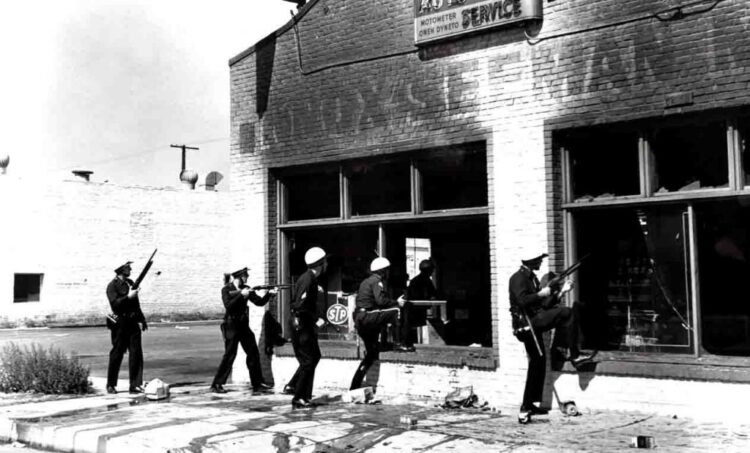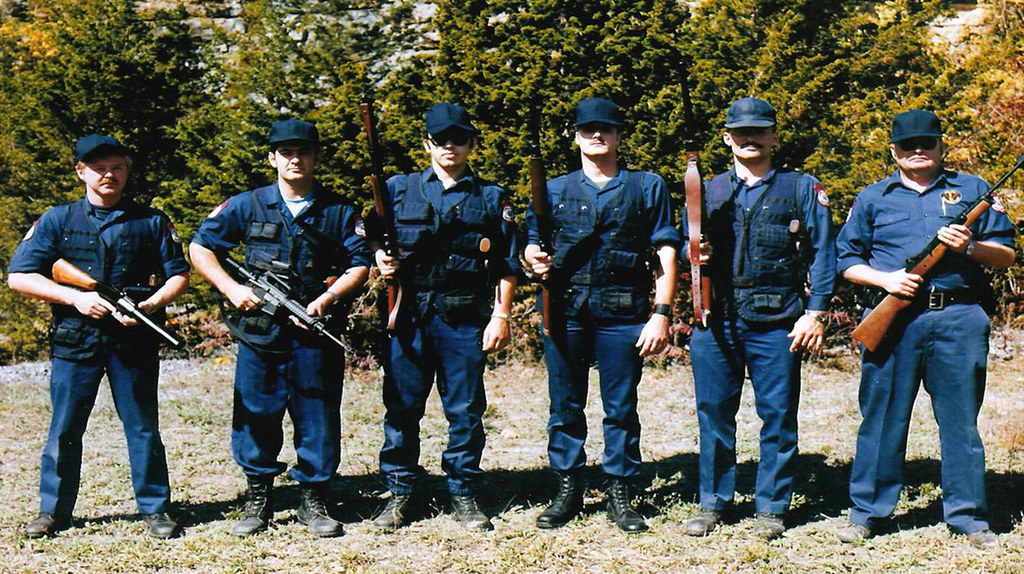Close Quarters Battle (CQB) tactics are a vital component of modern warfare and law enforcement operations. The roots of these tactics can be traced back to the intense combat environments of World War II, where fighters had to adapt to the challenges of urban warfare. The influence of WWII combat, and one major event in Los Angeles history ushered in the development of modern Special Weapons and Tactics (SWAT) teams.
Confronted with fortified buildings, narrow streets, and intricate urban landscapes, conventional tactics had to be modified to ensure success. To effectively engage enemy forces within confined spaces, soldiers developed various room clearing techniques. Techniques such as “mouse-holing” (creating small openings in walls for quick entry), “bounding overwatch” (advancing in pairs while providing mutual cover and support), and the “leapfrog” method (alternating advances to maintain fire superiority) were employed to neutralize threats efficiently and minimize casualties.
As World War II progressed, specialized units such as the British Commandos, German SS troops, and Soviet Urban Assault Teams were formed to handle the unique challenges of urban warfare. These units utilized tactics like small team infiltration, surprise raids, and dynamic assaults to gain an advantage over the enemy in close quarters. Post-World War II, there was great influence on law enforcement on an individual basis from the lessons learned in urban combat, particularly in response to high-risk situations and hostage scenarios but not in a cohesive way. The development of SWAT teams in the late 1960s and early 1970s marked a significant turning point for the application of tactics in large cities, and for police departments.
The specific birth of the LAPD SWAT team can be traced back to the tumultuous events of the 1960s. The Watts Riot in 1965 and the resulting urban unrest highlighted the need for a specialized law enforcement unit capable of handling dangerous situations beyond the capabilities of regular patrol officers. An American police officer by that name of John G. Nelson (14 May 1928 – 28 February 2003) personally approached LAPD chief William Parker with his proposal for a SWAT unit, after the Watts Riot. Nelson is considered to be the founding father of the SWAT (Special Weapons And Tactics) concept. Nelson used his experience in the United States Marine Corps Recon units as his basis for SWAT. LAPD Inspector Daryl Gates recognized the need for a specialized police team, after learning about Nelson’s proposal.
In 1967, he formed the first Special Weapons and Tactics unit, originally known as Special Weapons Attack Team, later renamed Special Weapons and Tactics (SWAT) because decision makers disliked the word Attack. Nelson used the same proposal, and added the name change. The first SWAT Unit consisted of 15 four-man teams. Members of each team, who volunteered from the ranks of patrol and other police assignments, had specialized experience and prior military service.
The first significant deployment of LAPD’s SWAT unit was on December 9, 1969, in a four-hour confrontation with members of the Black Panthers. The Black Panthers resisted and attempted to shoot it out with 40 members of the SWAT Team. In May 1974, LAPD SWAT were involved with a far-left militant organization that called themselves The United Federated Forces of the Symbionese Liberation Army (SLA). Six members died in a shootout with police. By 1974, there was a general acceptance of SWAT as a police resource in Los Angeles.
Recognizing the need for specialized training and tactics to handle high-risk situations, SWAT teams were formed to address hostage rescues, barricaded suspects, and terrorist incidents. SWAT teams drew inspiration from military CQB techniques and adapted them to suit law enforcement requirements. Concepts like dynamic entry, deliberate movement, use of cover and concealment, and effective communication were integrated into their training and operations. Recognizing the importance of collaboration and learning from diverse perspectives, the LAPD SWAT team has sought to establish partnerships with renowned European hostage rescue units. The exchange of knowledge, tactics, and operational experiences strengthens the capabilities of all involved units and fosters an international network of elite law enforcement professionals.
In 1983, the Department sent three SWAT supervisors to Europe to evaluate and develop the techniques employed by military groups such as the GS9 – Germany’s Special Deployment Commando, and the French GIGN, France’s Elite Counterterrorism Unit: The French National Gendarmerie Intervention Group. They also worked with the legendary British 22nd SAS.

GIGN is widely regarded as one of the world’s premier counterterrorism units. The LAPD SWAT team has engaged in joint training exercises and knowledge-sharing sessions with GIGN to enhance their hostage rescue capabilities. The German GS9, is an elite hostage rescue unit renowned for its operational excellence. Collaborative training efforts between the LAPD SWAT team and GS9 enable the sharing of tactical expertise and specialized knowledge. GS9 has proficiency in breaching methods, including the use of specialized tools and explosives, which enriched the LAPD SWAT team’s knowledge of tactical breaching options. GS9 also enhanced the LAPD SWAT team’s close-quarters combat skills, including advanced combat shooting, hand-to-hand combat techniques, and room clearing tactics. The exchange promotes the refinement of individual and team-level skills crucial for successful hostage rescue operations.
Since their inception, SWAT teams have continued to refine and adapt their tactics to meet the evolving challenges of modern law enforcement. There is a continual refining of instruction, and there is specialization to deal with the demands of counterterrorism, active shooter scenarios, and hostage rescue missions. These situations have pushed these specialized units to enhance their CQB tactics and equipment.
SWAT team members undergo rigorous training programs that emphasize marksmanship, tactical movement, close-quarters engagement, and hostage rescue techniques. The integration of technology, such as night vision devices, body armor, and specialized breaching tools, has further enhanced their capabilities. Modern SWAT teams prioritize coordination, communication, and teamwork in their operations. They employ well-rehearsed team formations, rapid entry techniques, and coordinated fire and movement to neutralize threats effectively while minimizing collateral damage. The LAPD SWAT Team is known worldwide today as one of the foremost police tactical units in contemporary law enforcement.
*The views and opinions expressed on this website are solely those of the original authors and contributors. These views and opinions do not necessarily represent those of Spotter Up Magazine, the administrative staff, and/or any/all contributors to this site.


